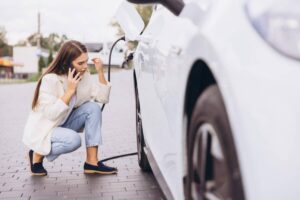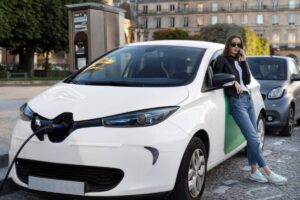The Automobiles & Vehicles Blog

Are Electric Cars Safer in a Collision?
When you picture a serious car accident, your thoughts probably turn to airbag deployment, metal crunching — and perhaps a petrol tank igniting. But as electric vehicles (EVs) continue to grow in popularity, the traditional ideas around crash safety are being rewritten.
One question continues to pop up among both curious buyers and safety-conscious sceptics: Are electric cars actually safer in a collision? Do they offer more protection, or does the presence of a high-voltage battery bring added risk?
This guide explores the world of EV crash safety, looks at electric car durability during impacts, and explains the vehicle safety features that set today’s electric vehicles apart. We’ll break down how EVs behave in collisions, what crash test data tells us, and how modern technology is shaping safer roads for all.
Whether you’re buying your first EV or just doing your homework, by the end, you’ll have a clear, confident answer.
Understanding EV Crash Safety: A New Kind of Protection
Why EVs Are Built Differently
Electric vehicles are not simply traditional cars with a battery swap. Their design is fundamentally different in ways that directly influence crash performance:
- Battery packs are positioned low and flat in the vehicle floor. This lowers the centre of gravity and reduces the chance of rollover accidents.
- No engine under the bonnet means more room for larger front crumple zones.
- The chassis is often reinforced to protect the battery from side and underbody impacts.
These elements work together to make many EVs inherently more stable and structurally resilient in certain collision scenarios.
The Myth vs. Reality of Battery Fire Risk
Let’s address the elephant in the room: battery fires.
- Myth: “EVs explode more easily than petrol cars.”
- Reality: EVs are no more likely to catch fire than conventional vehicles — and may even be less so.

A 2023 study from AutoInsuranceEZ using US data found that EVs had significantly fewer fire incidents per 100,000 sales compared to petrol and hybrid vehicles.
Manufacturers build EVs with:
- Thermal management systems
- Crash-triggered battery disconnects
- Sealed and reinforced battery enclosures
So while thermal runaway (an uncontrolled battery fire) is possible, it’s rare — and highly regulated by safety standards like UN R100 in Europe and FMVSS 305 in the US.
What the Crash Tests Say: Are EVs Holding Up?
Let’s dive into the data from trusted testing bodies.
Euro NCAP Results
Many of the top-rated EVs in recent years have achieved 5-star safety ratings — often matching or outperforming their petrol counterparts in adult and child occupant protection.
Some examples:
EV Model Adult Protection Child Protection Safety Assist Tesla Model Y 97% 87% 98% Hyundai Ioniq 6 97% 87% 90% Volvo EX90 96% 89% 94%
These results show that EVs not only offer excellent crash survivability but also come packed with features to help avoid crashes in the first place.
NHTSA Data (US)
According to the National Highway Traffic Safety Administration, EVs like the Tesla Model 3 and Model X have scored 5-star ratings across every crash category — frontal, side, and rollover.
NHTSA’s data supports the notion that electric vehicles are structurally sound, thanks to their rigid battery structures and balanced weight distribution.
Key Vehicle Safety Features Unique to EVs
What sets EVs apart isn’t just how they’re built — it’s the advanced tech that comes baked in.
1. Automatic Emergency Braking (AEB)

EVs often come with high-spec cameras and radar as standard. AEB can detect cars, pedestrians, and cyclists — and apply brakes to prevent or lessen collisions.
2. Regenerative Braking
Besides energy efficiency, regenerative braking helps you slow down quicker and more smoothly, potentially reducing the severity of rear-end collisions.
3. Advanced Driver Assistance Systems (ADAS)
These include:
- Lane-keeping assist
- Blind spot monitoring
- Adaptive cruise control
- Cross-traffic alerts
Most EVs offer Level 2 autonomy, meaning they actively assist the driver rather than just warn them.
4. Cabin Safety Technologies
Many newer EVs include:
- Post-collision braking, to stop runaway rolling after impact
- Occupant detection systems, alerting you if a child or pet is left inside
- Driver monitoring systems, ensuring you’re alert and attentive
Durability in the Real World: How EVs Fare in Crashes
EVs’ electric car durability isn’t just about test labs. Real-world scenarios prove how robust these cars can be.
Case Study: Tesla Model X Crash, Norway (2022)
A family of five walked away from a high-speed crash after hitting a barrier on a snowy road. The vehicle’s structure absorbed the impact, and the battery remained intact. Emergency services noted the minimal cabin intrusion and absence of post-crash fire.
Case Study: Hyundai Kona EV Fire, Canada (2021)
In a rare battery fire incident, investigations revealed improper charging habits and a faulty cell batch. Hyundai responded with an extensive recall and replaced battery packs in all affected vehicles.
These cases highlight two key takeaways:
- Crash survivability in EVs is very high due to rigid safety structures.
- Battery issues are rare, but manufacturers are proactive when problems arise.
How EV Weight Affects Safety
EVs are heavier than petrol cars — but is that good or bad?
The Good:
- Heavier vehicles tend to protect their occupants better in crashes.
- The low centre of gravity from battery placement improves handling and rollover resistance.
The Caution:
- In a crash with a lighter car, the EV may cause more damage to the other vehicle.
- Heavier cars can increase braking distance, though most EVs offset this with powerful regen and disc brakes.
Used EVs: What to Check for Safety Confidence
Even a second-hand EV can offer top safety — if you inspect carefully.
Used EV Safety Checklist:
- Ask for the original crash test scores by make and year.
- Ensure airbags and ADAS systems are intact and functional.
- Check that battery casing is undamaged and not corroded.
- Update the software — many safety features improve with updates.
Tip: Ask the seller if the car has had any manufacturer safety recalls — and whether they’ve been resolved.
Anecdote: Emma’s EV Escape
Emma, a paramedic from Kent, was T-boned in her Nissan Leaf by a speeding SUV. The Leaf spun out but the side curtain airbags and rigid battery floor prevented intrusion.
“I’ve seen plenty of wrecks at work. The fact I walked away with a bruise made me a lifelong EV convert.”
So, Are Electric Cars Safer in a Collision?
Yes — and here’s why.
Electric cars are not just safe. They’re smart, strong, and designed to protect. Their structural reinforcements, lack of engine block, and ultra-low centres of gravity make them more stable in many crash scenarios. And thanks to advanced tech like automatic braking, driver monitoring, and lane assist, they also help you avoid accidents altogether.
While battery fires make the headlines, the numbers tell a different story: EVs are statistically safer, tested more rigorously, and continually improved through software updates.









